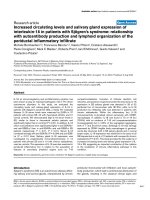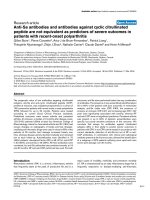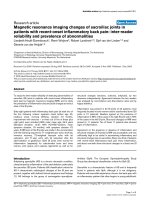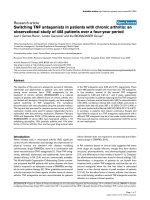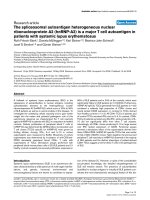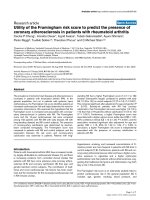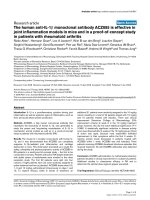Báo cáo y học: "Hypoalbuminaemia – A Marker of Cardiovascular Disease in Patients with Chronic Kidney Disease Stages II - IV"
Bạn đang xem bản rút gọn của tài liệu. Xem và tải ngay bản đầy đủ của tài liệu tại đây (208.7 KB, 5 trang )
Int. J. Med. Sci. 2008, 5
366
International Journal of Medical Sciences
ISSN 1449-1907 www.medsci.org 2008 5(6):366-370
© Ivyspring International Publisher. All rights reserved
Research Paper
Hypoalbuminaemia – A Marker of Cardiovascular Disease in Patients with
Chronic Kidney Disease Stages II - IV
Nehal Rachit Shah
1
and Francis Dumler
2
1. Division of Internal Medicine, St Joseph Mercy Oakland, Pontiac, MI, USA
2. Division of Nephrology, William Beaumont Hospital, Royal Oak, MI, USA
Correspondence to: Nehal Shah, MD, 727 Woodlawn Ave, Royal Oak, MI 48073. Email:
Received: 2008.08.13; Accepted: 2008.11.10; Published: 2008.11.12
Cardiovascular disease (CVD) is a major cause of morbidity and mortality in patients with chronic kidney disease
(CKD) patients. Serum albumin, a negative acute-phase reactant and marker for underlying inflammation and/or
malnutrition, is an independent predictor of CVD and mortality in CKD VI patients. Such an association in pa-
tients with less severe CKD is not well established.
We conducted a cross sectional study of all CKD II - IV patients attending the nephrology clinic (N=376; mean
age: 57±17 years; GFR: 47±20 mL/min/1.73m2; females 48%; blacks 15%; diabetics 27%; hypertensive 79%).
Laboratory and clinical data including risk factors and evidence of CVD were obtained at the point of the most
recent visit. The association between risk factors and CVD was evaluated by logistic regression. In the simple
logistic regression model, age (p<0.0001), sex (P= 0.02), hypertension (P<0.0001), diabetes (P<.0001), dyslipidemia
(p=.01), and serum albumin (p<.0001) were found to be statistically significant. Serum albumin was found to be
an independent predictor (p=0.04) of CVD by multiple logistic regression analysis using the above risk factor
variables.
In conclusion: a) hypoalbuminaemia is an independent predictor of CVD in early CKD stages; b) hypoalbu-
minaemia may be used to identify the population at higher risk for CVD.
Key words: Hypoalbuminaemia, cardiovascular disease, chronic kidney disease patients, cross sectional study
INTRODUCTION
400,000 Americans have ESRD and over 300,000
of these patients are on maintenance dialysis (1). CVD
is the leading cause of morbidity and mortality in these
patients accounting for more than 40% of hospitaliza-
tions and almost 50% of deaths (1, 2). This death rate
attributed to CVD is 10-20 times that in the general
population, stratified for age, race and gender (3).
An estimated 8 million patients have chronic
kidney disease of at least stage III (as defined by an
estimated glomerular filtration rate [GFR] of less than
60 ml per minute per 1.73 m
2
of body surface area) (4).
These patients are not on dialysis. However, the
prevalence of CVD in these patients has been shown to
be significantly higher than the general population (5,
6).
The high burden of CVD in these patients can not
be explained just by the high prevalence of traditional
risk factors like hypertension (HTN), diabetes (DM),
Dyslipidemia (DLP) and advanced age. Of late, novel
risk factors like malnutrition and inflammatory state
have been implicated in maintenance dialysis patients
(CKD stage VI). This association is not well established
in patients with less severe CKD. Here we evaluated
association between serum albumin, a negative
acute-phase reactant and marker of inflammation
and/or malnutrition and CVD in patients with CKD
stages II to IV.
METHODS
STUDY DESIGN
This is a cross sectional study of all CKD stage
II-IV (n= 376) patients attending nephrology clinic of a
community hospital. Excluded from initial sample of
583 patients were those with CKD stage I, V and those
with missing albumin values or CVD data. Patients
with a previous history of dialysis and/or renal trans-
plant were also excluded.
DATA COLLECTION
Data of age, sex, race, DM, HTN, serum chemis-
tries and CVD were collected from office charts and
from the most recent visit. All names and identifiers
Int. J. Med. Sci. 2008, 5
367
were removed before any analysis of data was per-
formed. Serum chemistries included blood urea ni-
trogen (BUN), serum creatinine, serum albumin, elec-
trolytes, calcium (Ca), phosphorus (PO4), uric acid,
lipids and hemoglobin. CVD included angina pectoris,
myocardial infarction (MI), coronary artery disease
(CAD), left ventricular hypertrophy (LVH) and heart
failure (HF) as per history.
RENAL FUNCTI0N
We used the abbreviated Modification of diet in
Renal Disease (MDRD) equation to estimate the GFR
(7, 8). Creatinine value on last visit was used to calcu-
late MDRD eGFR. The formula is as below:
186 x (Creat / 88.4)-1.154 x (Age)-0.203 x (0.742 if fe-
male) x (1.210 if black)
OUTCOMES AND COVARIATES
Outcomes were measured in form of prevalence
of CVD as defined above. Potential confounders se-
lected based on prior studies and clinical relevance,
including age, sex, HTN, DM and DLP were used in
final model.
STATISTICAL ANALYSIS
Results were expressed as mean ± SD for con-
tinuous variables, and as percentages for categorical
data. The association between potential risk factors
and CVD was evaluated by logistic regression model.
Simple logistic regression models were used to evalu-
ate associations of traditional and novel risk factors for
CVD. To evaluate the independent effect of serum al-
bumin on CVD, a multiple logistic regression model
was used. All variables known to be associated with
CVD involving all traditional risk factors like sex, age,
DM, HTN, DLP were put in final multiple logistic re-
gression model to remove confounding effects. Results
were reported as p values and Odds Ratios with 95%
confidence intervals. All analyses were conducted with
the use of STATVIEW software.
RESULTS
The patients included 52% male and 48% female,
85% white and 15% black and mean age was 57 years.
The majority of patients (79%) had HTN and 27% had
DM. CVD was prevalent in 35% of patients. A total of
62% were on angiotensin converting enzyme inhibitors
(ACE-i), 30% on beta blockers and 53% on statins (Ta-
ble 1). Laboratory data is shown in Table 2. All vari-
ables evaluated using simple logistic regression were
significant except serum cholesterol (Table 3). The ef-
fects of BUN, serum creatinine, calcium, phosphorus,
uric acid, and hemoglobin values on CVD were ac-
counted by the GFR status. Multivariate analysis
showed that GFR, serum albumin concentration, age,
male sex and presence of DM were the independent
predictors of CVD in the earlier stages of CKD (Table
4).
Table 1: Characteristics of patients with CKD stage II to IV
excluding patient with history of renal transplant or maintenance
dialysis.
Variable Value
Age (years) 57±17
Sex 48% Female,
52% Male
Race 15% Black,
85% White
Diabetes 27%
Hypertension 79%
Cardiovascular disease 35%
ACEi/ ARB 62%
Beta blockers 40%
Statins 53%
Table 2: Laboratory data of the study patients with CKD stage
II to IV including serum chemistries.
Parameter Mean ± SD
MDRD GFR (mL/min/1.73m
2
): 47 ± 20
BUN (mg/dL): 28 ± 16
S. Creatinine (mg/dL): 1.6 ± 0.7
S. Calcium (mg/dL): 9.4 ± 0.5
S. Phosphorus (mg/dL): 3.6 ± 0.6
S. Albumin (g/dL): 4.1 ± 0.5
S. Uric Acid (mg/dL): 7.0 ± 2.3
S. Cholesterol (mg/dL): 188 ± 43
S. Triglycerides (mg/dL): 169 ± 136
S. hemoglobin (g/dL): 13.2±1.8
Table 3: Univariate Logistic Regression Analysis evaluating
association of risk factors with CVD.
Variable Exp (coef.) P Value
Age: 1.065 0.0100
Sex (M): 1.689 0.0170
Race (W): 0.489 0.0140
HTN: 5.422 0.0001
DM: 3.849 0.0001
S. Phosphorus 1.609 0.0063
S. Uric Acid: 1.287 0.0001
GFR: 0.952 0.0001
S. Hemoglobin: 0.740 0.0001
S. Calcium 0.539 0.0041
S. Albumin: 0.376 0.0001
S. Cholesterol: 0.997 0.3377
Table 4: Multivariate Logistic Regression Analysis evaluating
independent effects of risk factors with CVD.
Variable P Value Exp (Coef.) OR (95% CI)
Age: 0.0001 1.043 (1.023-1.063)
Sex (M): 0.0280 1.788 (1.065-3.002)
HTN: 0.0714 2.127 (0.936-4.833)
DM: 0.0012 2.472 (1.430-4.273)
GFR: 0.0004 0.976 (0.961-0.992)
S. Albumin: 0.0365 0.554 (0.391-0.962)
DISCUSSION
The majority of patients with CKD have severe
manifestations of CVD by the time they need mainte-
Int. J. Med. Sci. 2008, 5
368
nance dialysis. This suggests that the damage to the
cardiovascular system starts quite early in the time
course of progressive chronic kidney disease. Indeed
over the last few years, it has been well recognized that
CKD patients in the predialysis stage are at increased
risk of CVD and its complications. This has led to a
rapidly growing interest in the relation between kid-
ney disease and the risk of CVD and is the focus of
several recent studies. These studies have shown that
the association of CKD to CVD is independent of any
traditional risk factors (9-12). The National Kidney
Foundation, American Heart Association and the
Seventh Joint National Committee on Prevention, De-
tection, Evaluation & Treatment of High Blood Pres-
sure have classified the presence of CKD as a cardio-
vascular risk factor (9, 13, 14). These findings led to the
evaluation of novel cardiovascular risk factors like
chronic inflammation and malnutrition as predictors
of the CVD in chronic kidney disease. This multifacto-
rial disease introduces new challenges in predicting
and treating patients early in course of CKD to posi-
tively alter patient outcome.
There is definitely a high prevalence of traditional
risk factors like HTN, DM and DLP in chronic kidney
disease patients (15-20), but this alone cannot explain
the existing high burden of CVD in this population
(21-24). There appears to be a close link between CVD,
malnutrion and inflammation in ESRD patients (25,
26). Hypoalbuminemia, a marker of malnutrition and
underlying inflammation has come up as a powerful
predictor of mortality in patients with ESRD (27-30)
and also a significant predictor for the occurrence of de
novo vascular events in this population (27). In a re-
cent study C-reactive protein and low albumin has
been shown to be the predictor of morbidity and mor-
tality in CKD 3-5 patients in Spain (31). Our study ex-
tends this finding to patients with more preserved
renal function in American population.
Our hypothesis that serum albumin is a signifi-
cant risk factor for cardiovascular disease in CKD pa-
tients is highlighted by our results on 376 patients with
CKD II to IV in whom low serum albumin was sig-
nificantly associated with CVD irrespective of tradi-
tional risk factors like age, sex, HTN, DM and DLP in
multivariate analysis.
Beddhu et al (32) showed association between
serum albumin level and CVD in chronic hemodialysis
patients. An association between serum albumin and
cardiovascular mortality has been reported by several
studies. Owen et al (33) demonstrated that hypoalbu-
minemia was a strong predictor of mortality in dialysis
patients. Kalantar-Zadeh et al (34) also showed higher
mortality in dialysis patients with lower albumin.
Many recent studies showed serial measurement of
serum albumin can even better predict chronic in-
flammation and clinical events (35-37). Looking at the
results of all these studies it is clear that hypoalbu-
minemia is adversely associated with CVD in ESRD.
Stenvinkel et al. (38) were first to demonstrate that
patients in predialysis chronic renal failure with ca-
rotid plaque has lower serum albumin level. Nobuhiko
et al demonstrated that even in predialytic phase of
chronic renal failure, hypoalbuminemia is an excellent
reflection of CVD (39). Our study concludes that this is
true even in patients with less severe kidney dysfunc-
tion. So serum albumin can be a helpful predictor of
CVD at early stage of CKD and this patient population
needs focused attention because early detection and
intervention can provide better outcome.
Available data suggests interrelationship be-
tween hypoalbuminemia, inflammation, malnutrition
and atherosclerosis in patients with kidney failure (38,
40). In some studies the relation between hypoalbu-
minemia and CVD is the reflection of inflammation
induced malnutrition. The underlying mechanism be-
hind this includes appetite suppression and increased
catabolism by inflammatory cytokines (38). Cai and
colleagues have implied serum albumin as potential
scavenger of free radicals. Decrease in serum albumin
level would lead to decrease antioxidant capacity and
favor the noxious effects of oxidative stress on a vari-
ety of tissues, including the arterial vessel wall (41).
These data suggest that hypoalbuminaemia can be
more appropriately viewed as a composite marker
which reflects malnutrition as well as increased acute
phase inflammation, considering that albumin is also a
negative acute phase reactant (38, 42-45).
Our study has several limitations. This was a
retrospective chart review. Patients were not followed
over time, so causal relationships cannot be estab-
lished. We have not used serum albumin as a time
dependent covariate which may have led to an even
more reliable prediction of CVD. In addition, many of
our patients were on medications that have protective
effects on cardiovascular disease. Another important
limitation is the lack of consistent measurements of
other inflammatory markers such as CRP, whose im-
portance as a predictor of CVD has been shown by
others (46). Hypoalbuminemia is a non specific marker
of a micro inflammatory state, and is seen in other
diseases such as systemic lupus, rheumatoid arthritis,
other connective tissue diseases, liver disease, malnu-
trition from other causes, and does not just represent
cardiovascular disease. In addition, data on food in-
take, basal energy expenditure (BEE), and total daily
energy expenditure (TEE) were not available for
analysis that may have provided a better understand-
ing of nutritional status in these patients.
Int. J. Med. Sci. 2008, 5
369
Our study concludes that hypoalbuminemia is a
strong risk factor for CVD, probably in context of the
complex syndrome of malnutrition, inflammation and
oxidative stress in patients with CKD. In order to re-
duce cardiovascular mortality, nutritional,
anti-inflammatory and antioxidant intervention will
need to be assessed in more randomized control trials.
Statins and ACE inhibitors have been shown to have
anti-inflammatory effects (47, 48). Recent studies have
shown beneficial effects of statins on CVD outcome in
CKD patients (49-51). But it is unclear whether the
benefit is due to lipid lowering effect, an anti inflam-
matory effect or both.
Conflict of Interest
The authors have declared that no conflict of in-
terest exists.
References
1. Renal Data System. USRDS 2003 annual data report: atlas of
end-stage renal disease in the United States. Bethesda: National
Institutes of Health, National Institute of Diabetes and Digestive
and Kidney Diseases, 2003.
2. Locatelli F, Marcelli D, Conte F et al. Cardiovascular disease in
chronic renal failure: the challenge continures. Registro
Lombardo Dialisi e Trapianto. Nephrol Dial Transplant 2000; 15
(Suppl 5): 69-80.
3. Foley RN, Parfrey PS, Sarnak MJ. Clinical epidemiology of car-
diovascular disease in chronic renal disease. Am J Kideny Dis
1998; 32 (Suppl 3): S112-119.
4. Coresh J, Astor BC, Greene T, Eknoyan G, Levey AS. Prevalence
of chronic kidney disease and decreased kidney function in the
adult US population: Third National Health and Nutrition Ex-
amination Survery. Am J Kidney Dis 2003; 41: 1-12.
5. Culleton BF, Larson MG, Wilson PW, Evans JC, Parfrey PS, Levy
D. Cardiovascular disease and mortality in a community based
cohort with mild renal insufficiency. Kidney Int. 1999; 56:
2214-19.
6. Shilpak MG, Fried LF, Crump C et al. Cardiovascular disease
risk status in elderly persons with renal insufficiency. Kidney
Int. 2003; 62: 997-1004.
7. Levey AS, Bosch JP, Lewis JB, Greene T, Rogers N, Roth D. A
more accurate method to estimate glomerular filtration rate from
serum creatinine: a new prediction equation. Ann Intern Med
1999; 130: 461-470.
8. Levey AS, Greene T, Kusek JW, Beck GJ. A simplified equation
to predict glomerular filtration rate from serum creatinine. J Am
Soc Nephrol 2000; 11: 155A-155A.
9. Sarnak MJ, Levey AS, Schoolweth AC, et al. Kidney disease as a
risk factor for development of cardiovascular disease: a state-
ment from the American Heart Association Councils on Kidney
in Cardiovascular Disease, High Blood Pressure Research,
Clinical Cardiology, and Epidemiology and Prevention. Circu-
lation 2003; 108: 2154-2169.
10. Shilpak MG, Simon JA, Grady D, Lin F, Wenger NK, Furberg
CD. Renal insufficiency and cardiovascular events in post-
menopausal women with coronary heart disease. J Am Coll
Cardiol 2001; 38: 705-
11. Shulman NB, Ford CE, Hall WD, et al. The Hypertension Detec-
tion and Follow-up Program Group. Prognostic value of serum
creatinine and effect of treatment of hypertension on renal func-
tion results from the Hypertension Detection and Follow-up
Program. Hypertension. 1989 May;13(5 Suppl):I80-93.
12. Mann JF, Gerstein HC, Pogue J, Bosch J, Yusuf S. Renal insuffi-
ciency as a predictor of cardiovascular outcomes and the impact
of ramipril: the HOPE randomized trial. Ann Intern Med. 2001;
134: 62
13. Chobanian AV, Bakris GL, Black HR, et al. The Seventh Report
of the Joint National Committee on Prevention, Detection,
Evaluation, and Treatment of High Blood Pressure: the JNC 7
report. JAMA 2003; 289: 2560-2572.
14. Kidney Disease Outcome Quality Initiative. K/DOQI clinical
practice guidelines for chronic kidney disease: evaluation, clas-
sification, and stratification. Am J Kideny Dis 2002; 39(suppl 2):
S1-S24.
15. Linder A, Charea B, Sherrard DJ, et al. Accelerated atherosclero-
sis in prolonged maintenance hemodialysis. N Engl J Med. 1974;
:290-701.
16. Junger P, Massy ZA, Khoa TN, et al. Incidence and risk factors of
atherosclerotic cardiovascular accidents in predialysis chronic
renal failure patients: a prospective study. Nephrol Dial Trans-
plant 1997; 12: 2597-2602.
17. Herzog CA
, Ma JZ, Collins AJ. Poor long term survival after
acute myocardial infarction among patients on long term dialy-
sis. N Engl J Med 1998; 339: 799-805.
18. Parfrey PS, Foley RN. The clinical epidemiology of cardiac dis-
ease in chronic renal failure. J Am Soc Nephron. 1999; 10:
1606-1615.
19. D’Elia JA, Weinrauch LA, Gleason RE, et al. Application of the
ambulatory 24-hour electrocardiogram in the prediction of car-
diac death in dialysis patients. Arch Intern Med. 1988; 148:
2381-2385.
20. Aronow Ws. Usefulness of serum creatinine as a marker for
coronary events in elderly patients with either systemic hyper-
tension or diabetes mellitus. Am J Cardiol. 1991; 68: 678-679.
21. Levin A, Foley RN. Cardiovascular disease in chronic renal
insufficiency. Am J Kidney Dis. 2003; 36: S24-30.
22. Danesh J, Collins R, Peto R. Lipoprotein (a) and coronary heart
disease. Meta-analysis of prospective studies. Circulation. 2000;
102: 1082-5.
23. Schaefer EJ, Lamon-Fava S, Jenner JL, McNamara JR, Ordovas
JM, Davis CE, et al. Lipoprotein (a) levels and risk of coronary
heart disease in men. The Lipid Research Clinics Coronary Pri-
mary Prevention Trial. JAMA. 1994; 271: 999-1003.
24. Ridker PM, Cushman M, Stampfer MJ, Tracy RP, Hennekens
CH. Inflammation, aspirin, and the risk of cardiovascular dis-
ease in apparently healthy men. N Engl J Med. 1997; 336: 973-9.
25. Bergstrom J, Lindholm B: Malnutrition, cardiac disease, and
mortality: An integrated point of view. Am J Kidney Dis 1998;
32: 834-841.
26. Zimmermann J, Herrlinger S, Pruy A, Metzger T, Wanner C.
Inflammation enhances cardiovascular risk and mortality in
hemodialysis patients. Kidney Int 1999; 55: 648-658.
27. Foley RN, Parfrey PS, Harnett JD, et al. Hypoalbuminemia,
cardiac morbidity, and mortality in end-stage renal disease. J
Am Soc Nephrol 1996; 7: 728-736.
28. Owen WF, Lew NL, Liu Y, et al. The urea reduction ratio and
serum albumin concentration as predictors of mortality in pa-
tients undergoing hemodialysis. N Engl J Med. 1993; 329:
1001-1006.
29. Iseki K, Kawazoe N, Fukiyama K. Serum albumin is a strong
predictor of death in chronic dialysis patients. Kidney Int 1993;
44: 115-119.
30. Avram MM, Mittman N, Bonomini L, et al. Markers for survival
in dialysis: A seven-year prospective study. Am J Kidney Dis
1995; 26: 209-219.
31. Soriano S, González L, et al. C-reactive protein and low albumin
are predictors of morbidity and cardiovascular events in chronic
kidney disease (CKD) 3-5 patients. Clinical nephrology 2007;
67(6):352-7.
Int. J. Med. Sci. 2008, 5
370
32. Beddhu S, Kaysen GA, Yan G, Sarnak M, Agodoa L, Ornt D,
Cheung AK, HEMO Study Group. Association of serum albu-
min and atherosclerosis in chronic hemodialysis patients. Am J
Kidney Dis 2002; 40: 721-727.
33. Owen WFJr, Lew NL, Liu Y, Lowrie EG, Lazarus JM. The reduc-
tion ratio and serum albumin concentration as predictors of
mortality in patients undergoing hemodialysis. N Engl J Med
1993; 329: 1001-1006.
34. Kalantar-Zadeh K, Kilpatrick RD, Kuwae N et al. Revisiting
mortality predictability of serum albumin in the dialysis popu-
lation: time dependency, longitudinal changes and popula-
tion-attributable fraction. Nephrol Dial Transplant 2005; 20:
1880-1888.
35. Kaysen GA, Dubin JA, Muller HG, Rosales L, Levin NW, Mitch
WE, HEMO study group. Inflammation and reduced albumin
systhesis associated with stable decline in serum albumin in
hemodialysis patients. Kidney Int 2004; 65: 1408-1415.
36. Nacimiento MM, Pecoits-Filho R, Qureshi AR et al. The prog-
nostic impact of fluctuating levels of C-reactive protein in Bra-
zilian haemodialysis patients: a prospective study. Nephrol Dial
Transplant 2004; 19: 2803-2809.
37. Tsirpanlis G, Bagos P, Ioannou D et al. Exploring inflammation
in hemodialysis patients: persistent and superimposed inflam-
mation. A longitudinal study. Kidney Blood Press Res 2004; 27:
63-70.
38. Stevinkel P, Heimburger O, Paultre F et al. Strong association
between malnutrition, inflammation, and atherosclerosis in
chronic renal failure. Kidney Int 1999; 55: 1899-1911.
39. Nobuhiko Joki, Hiroki Hase, Yuri Tanaka et al. Relationship
between serum albumin level before initiating haemodialysis
and angiographic severity of coronary atherosclerosis in
end-stage renal disease. Nephrol Dial Transplant 2006; 21(6):
1633-1639.
40. Kalantar-Zadeh K, Kopple JD, Block G, et al. A malnutri-
tion-inflammation score is correlated with morbidity and mor-
tality in maintenance hemodialysis patients. Am J Kidney Dis
2001; 38: 1251-1263.
41. Cai H, Harrison DG. Endothelial dysfunction in cardiovascular
diseases: the role of oxidant stress. Circ Res 2000; 87: 840-844.
42. Mitch WE. Malnutrition: a frequent misdiagnosis for hemodi-
alysis patients. J Clin Invest 2002; 110: 437-439.
43. Kaysen GA. Biological basis of hypoalbuminemia in ESRD. J Am
Soc Nephrol 1998; 9: 2368-2376.
44. Kaysen GA, Dubin JA, Muller HG, Rosales LM, Levin NW. The
acute-phase response varies with time and predicts serum al-
bumin levels in hemodialysis patients. The HEMO Study Group.
Kidney Int 2000; 58: 346-352.
45. Kaysen GA, Chertow GM, Adhikarla R, Young B, Ronco C,
Levin NW. Inflammation and dietary protein intake exert com-
peting effects on serum albumin and creatinine in hemodialysis
patients. Kidney Int 2001; 60: 333-340.
46. Himmelfarb J, Stenvinkel P, Ikizler TA, and Hakim RM: The
elephant of uremia: oxidative stress as a unifying concept of
cardiovascular disease in uremia. Kidney Int 2002; 62: 1524-1538.
47. Stenvinkel P, Alvestrand A. Inflammation in end-stage renal
disease: sources, consequences, and therapy. Sem Dial 2002; 15:
329-337.
48. Wanner C, Metzger T. C-reactive protein - a marker for all-cause
and cardiovascular mortality in haemodialysis patients. Nephrol
Dial Transplant 2002; 17(Supply 8): 29-32.
49. Sever PS, Dahlof B, Poulter NR, Wedel H, Beevers G, Caulfield
M, et al. Prevention of coronary and stroke events with atorvas-
tatin in hypertensive patients who have average or
lower-than-average cholesterol concentrations, in the An-
glo-
Scandinavian Cardiac Outcomes Trial-Lipid Lowering Arm
(ASCOT-LLA): a multicentre randomized controlled trial. Lancet
2003; 361(9364): 1149-58.
50. Heart Protection Study Collaborative Group. MRC/BHF Heart
Protection Study of cholesterol lowering with simvastatin in
20,536 high-risk individuals: a randomized placebo-controlled
trial. Lancet 2002; 360(9326): 7-22.
51. Tonelli M, Isles C, Curhan GC, Tonkin A, Pfeffer MA, Shepherd
J, et al. Effect of pravastatin on cardiovascular events in people
with chronic kidney disease. Circulation 2004; 110(12): 1557-63.



